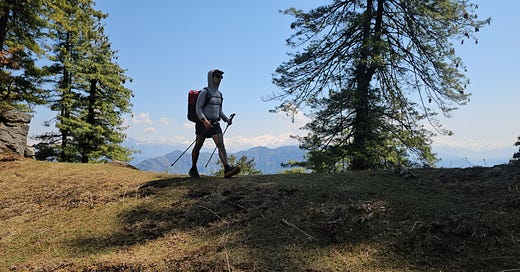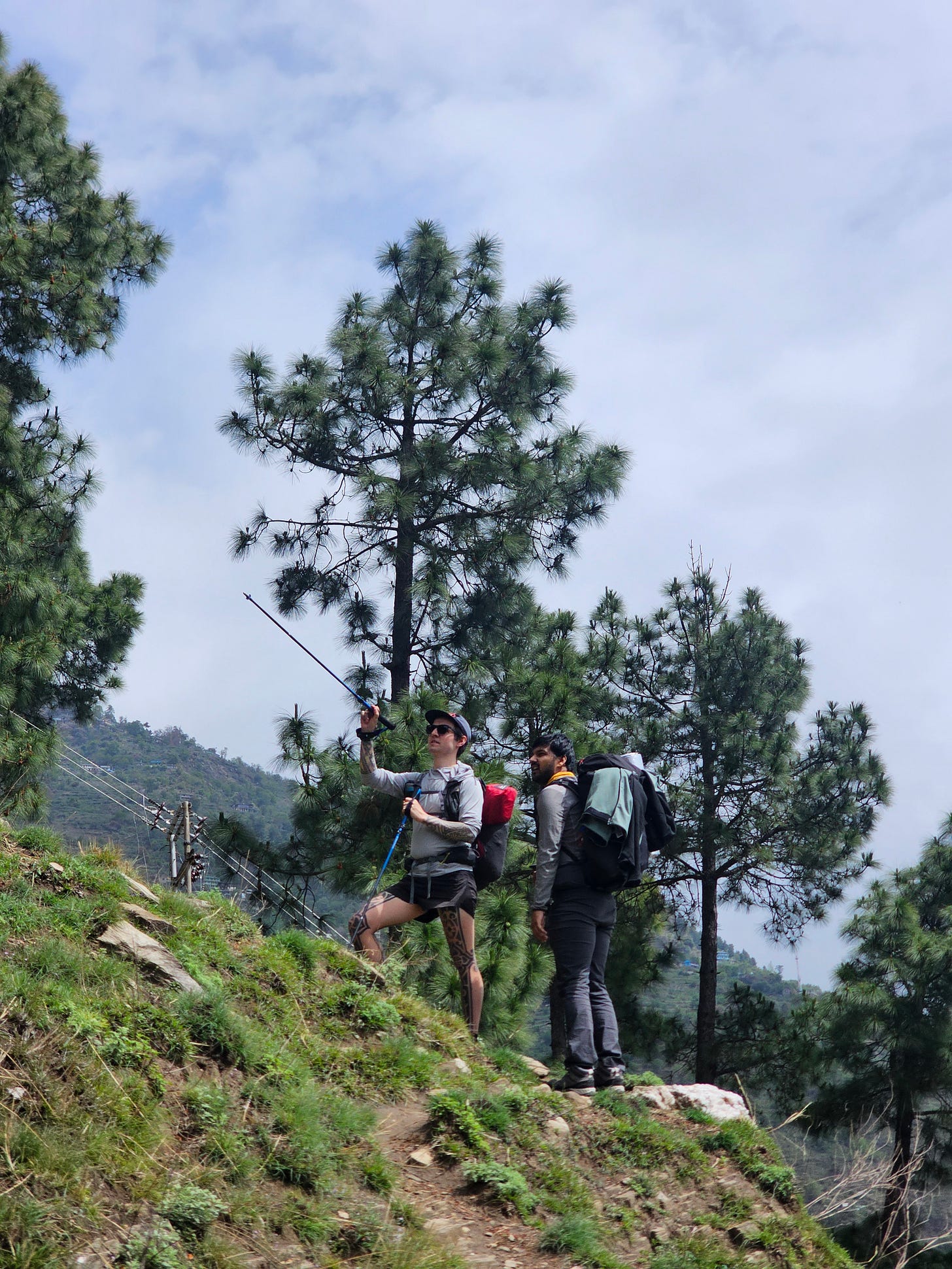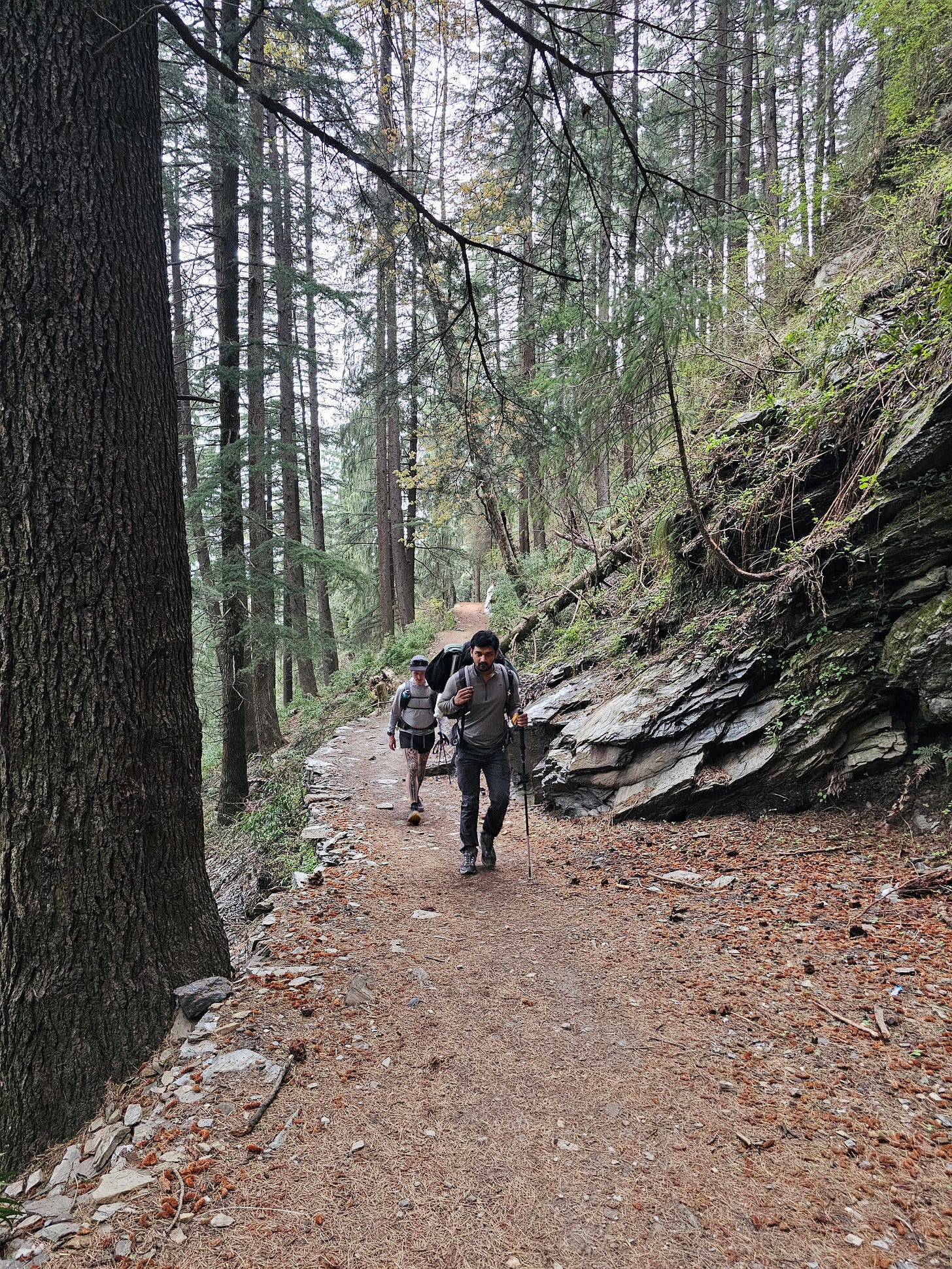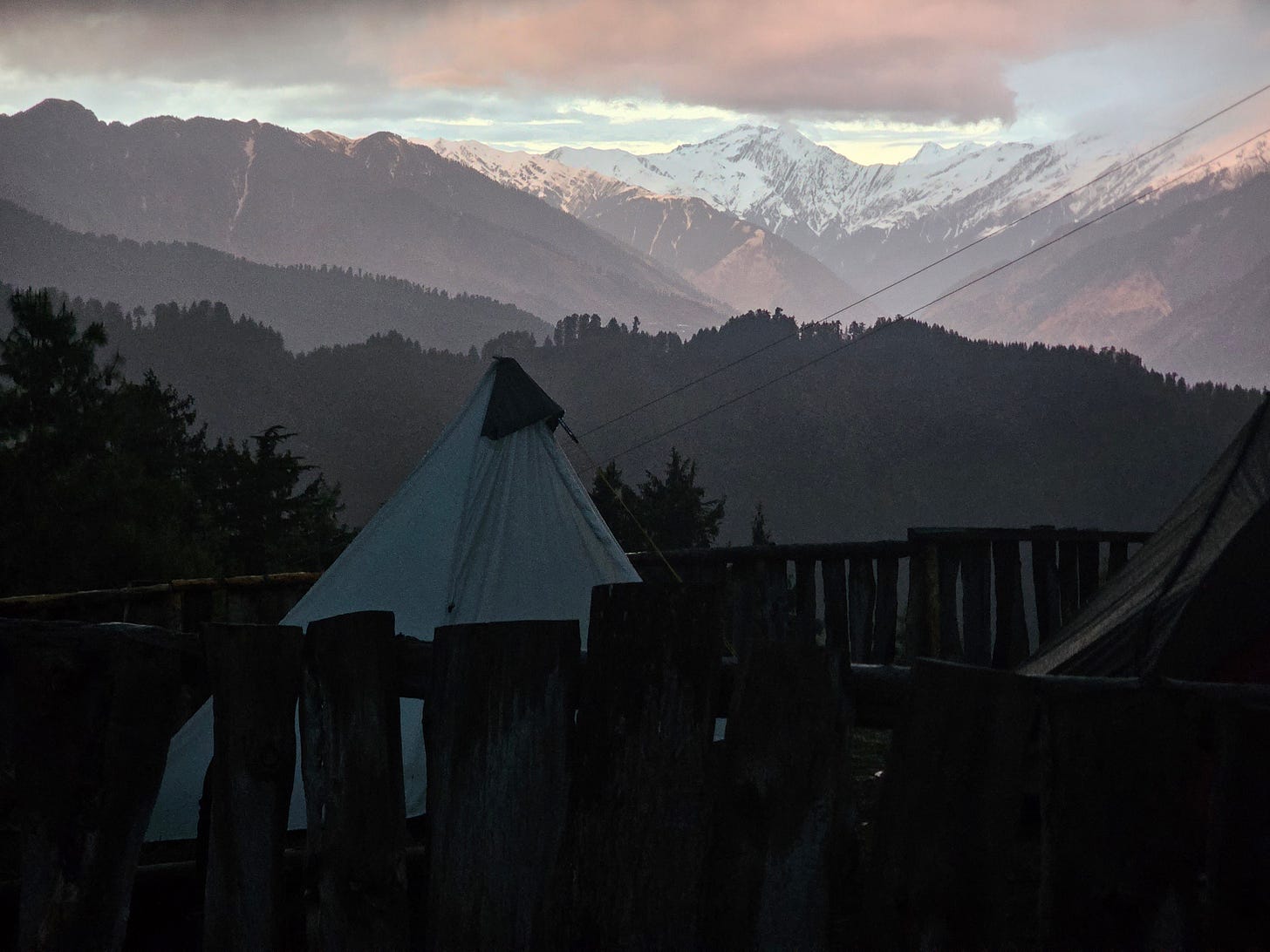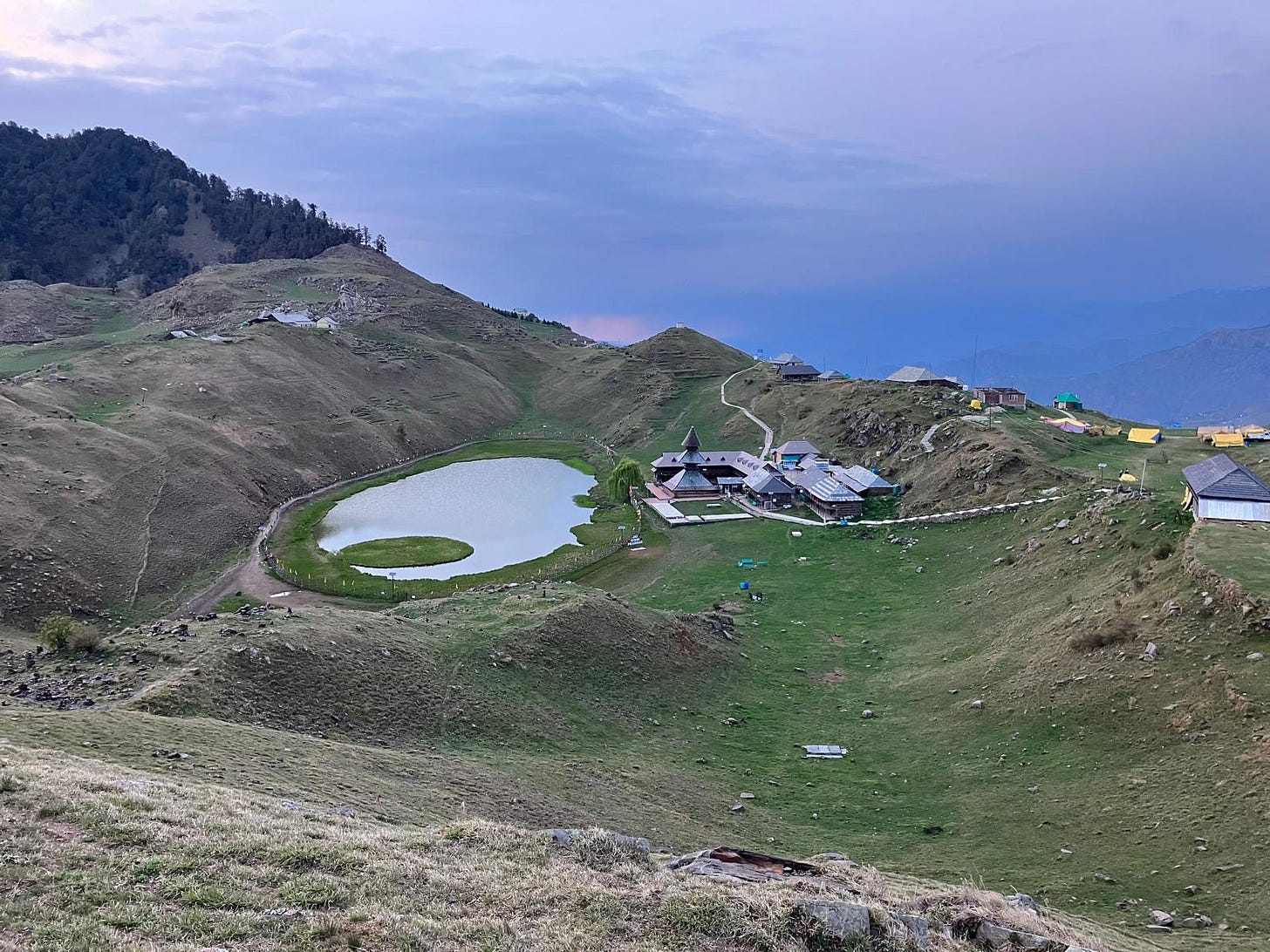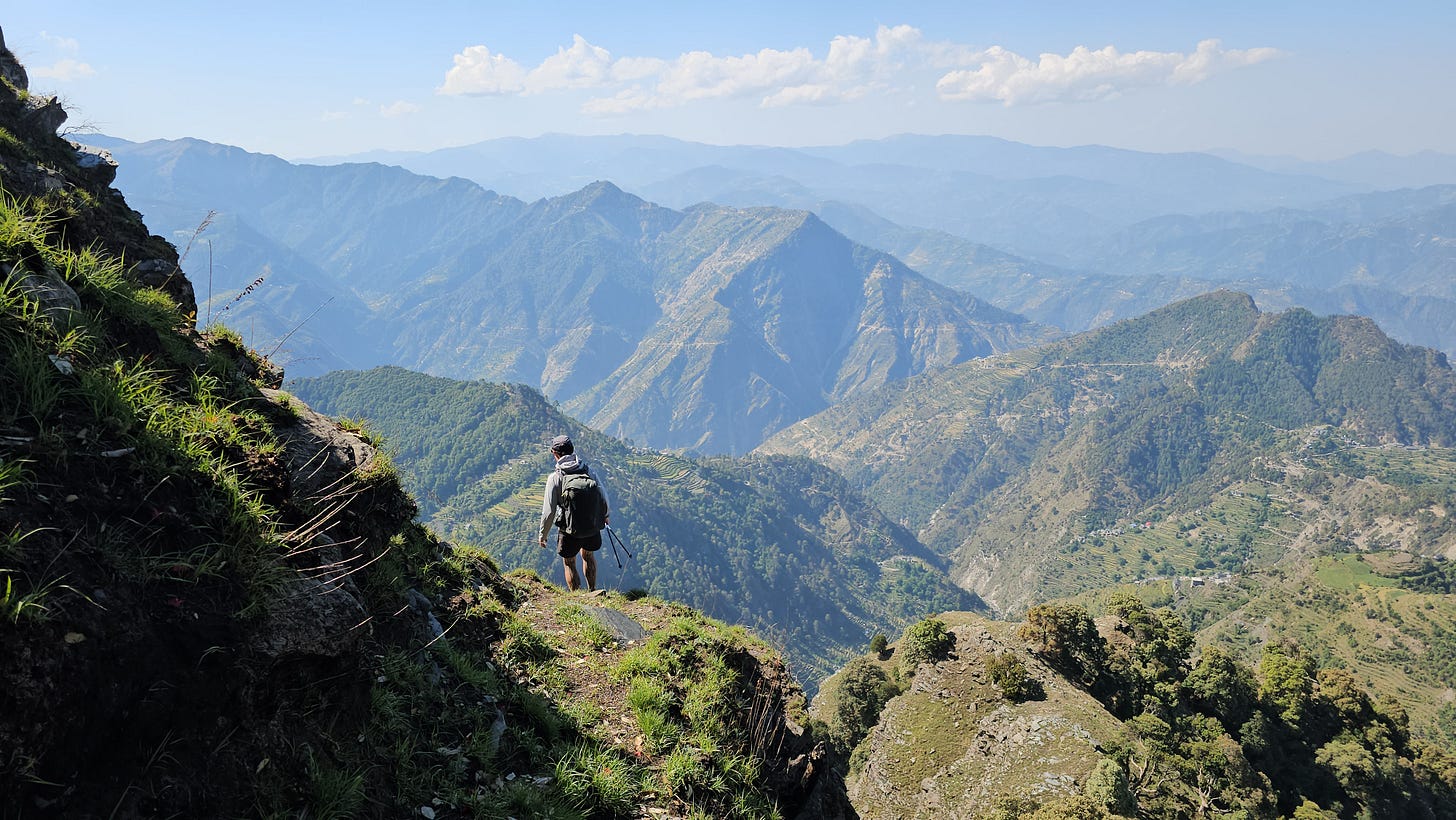After another week of solid base building in Manali (including this climb up Patalsu Peak), it was time for the first proper multi-day hike of the trip.
Through his online community Creedaz, Manav hosts what he calls 'community hikes'. Anyone who's a member of the community can join, and while the route has been sketched out by Manav in advance, navigation and deciding how far to push each day is a group responsibility. And so it was that four of us met at the Kullu bus stand (about an hour south of Manali), early on a Saturday morning. After some quick introductions, we packed up a few parathas from a dhaba (a simple roadside cafe), and started to climb out of the bustling market town.
The plan was to hike to the south west following a series of ridges and valleys, eventually reaching the pilgrimage site of Prashar Lake five or six days later. We would be on lower, snow-free slopes (always staying below 3000m), linking up villages in the Himachali foothills. We would carry two tents, and enough food to get us safely to the next village where we could resupply. The team consisted of Manav, me, Arpit and Nishant, two community-members who had travelled up from Mumbai.
Just a few minutes into the steep climb out of the valley, it was clear Arpit was struggling. The cheap backpack he had arrived with was far too heavy (we had insisted he unload a few kilos of unnecessary weight at the dhaba for collection later), and the sun-exposed climb was unforgiving. By the time we eventually reached a small road at the top of the hill, Manav diplomatically suggested Arpit hitchhike back to Kullu and take a bus to Manali where he could collect a spare, more comfortable backpack, offload more weight, and re-join the hike a day or two later. He mercifully agreed, and the remaining three of us continued along the ridge, finally cresting the hill and leaving the noise of Kullu behind. As we entered the picture-perfect hamlet of Shilabai, I was hit by a wave of elation. The village is centered around a small mandir built in the traditional Kath-Kuni style. Children played on the green in front of the temple, as the adults tended to nearby terraces of barley. Clouds gathered on the distant horizon to our west, and a gentle breeze blew across the ridge. These were the scenes I had been dreaming of from my bedroom in Leeds. The hike had begun.
The next few miles followed a beautiful, wide trail through the forests of Kais Dhar. We were cooled by the first drops of rain, and spent a blissful hour or so making good progress south before the real storm began. We sheltered for a while under an overhanging cliff, before pushing on between bouts of hail, reaching a small dhaba on the open meadow. The proprietor was a kindly Charlie Chaplain lookalike, who rushed into action to prepare us hot coffee and plates of food. We slowly dried out before using a short gap in the rain to hurriedly pitch our tents on a nearby patch of grass.
It was a cold night, and I was grateful for the heavy-duty down bag I'd brought for the high mountains later in the year. Uncle-ji (in South Asia, you refer to every elder as Aunty or Uncle, regardless of relation, and the suffix -ji is a gender-neutral term of respect, similar to the Japanese -san) prepared us bread omelettes for breakfast, and we packed roti and sabji (mixed vegetables) for later. The hike began by skirting round a hillside on top of which sits the ruins of Chamba Garh Fort, and then a steep descent into Bansu, another idyllic Himalayan hamlet. We caught the attention of an old man sat on his porch, and we couldn't resist stopping for a while to chat. The locals here speak a variety of Himachali languages, and Manav used a combination of Hindi and Kullui to make conversation. I asked how old he was, to which he casually replied “eighty or ninety. There is a woman working in the fields who is one hundred!”. Like old men sat on porches everywhere, he loved to talk, and after half an hour or so we reluctantly prised ourselves away.
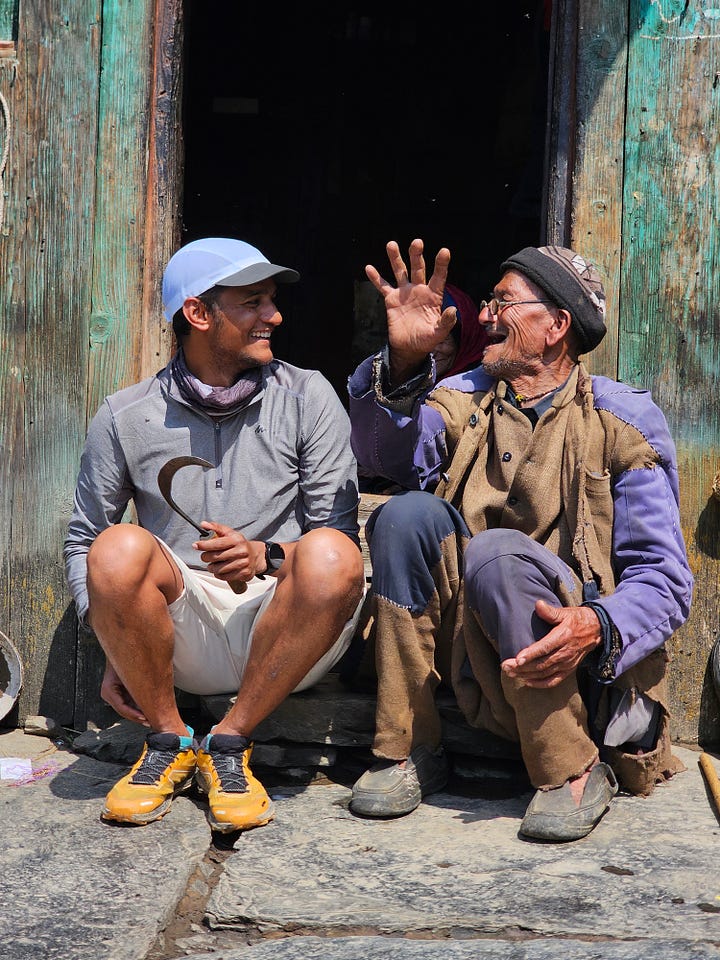
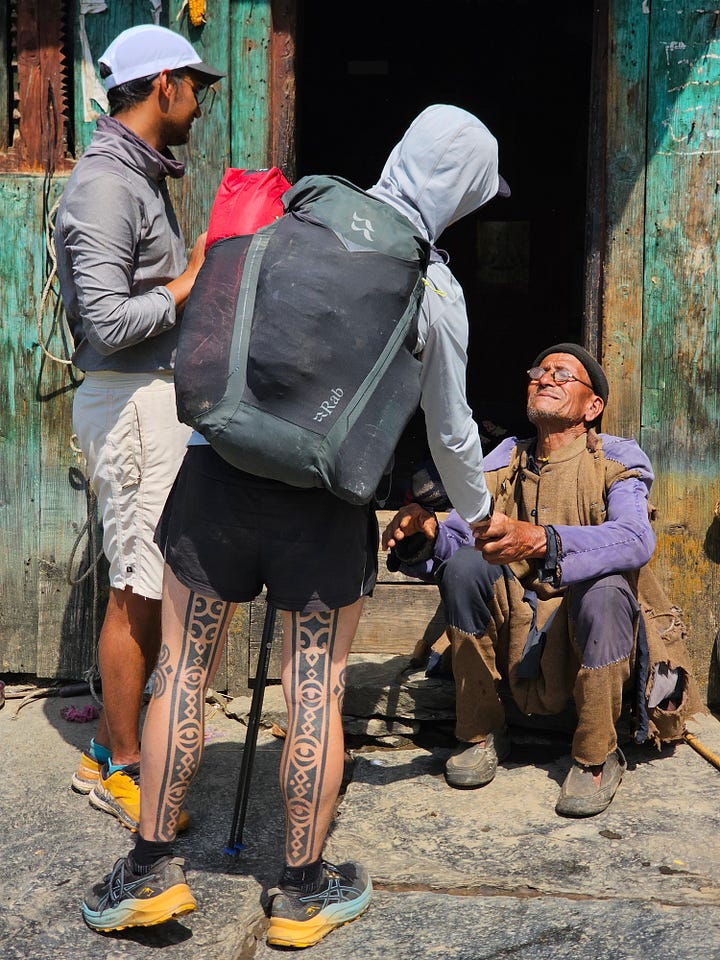
In the bottom of the valley we found a cold nala (river or stream), and took an icy dip before starting the serious climb of the day, 1000m or so to the pass of Pauni Jot. The climb was tiring and slow, and by the time we crossed the pass and started descending through the rhododendrons, we were grateful for the downhill. Our goal was the village of Arang, 1200m below us in the valley, but at some point we lost the trail and spent a frustrating couple of hours picking our way through steep meadows, finally reaching the road just before sunset. We asked a shepherdess for directions, who Manav struggled to fully understand (we had now crossed into Mandi district, where the locals speak Mandeali), but one word kept coming up – dhaam. She insisted we go to the local temple, where tonight the villagers would gather for a traditional feast to mark the beginning of spring. We readily obliged, and at the the temple we were welcomed as guests of honour, my presence in particular (as the one foreigner of the group) causing a small commotion. I'm no stranger to this reaction. Nine years ago as a young and eager 24 year old, I'd walked coast-to-coast across central India for 1200 miles, and my arrival in remote villages usually garnered an equal mix of confusion and excitement. The village elders and priests came to shake hands and take pictures, and after the puja (worship) was over, we were fed until we could eat no more. The priest also insisted we stay in a room in the temple complex, and so that night we laid out our sleeping mats on the floor and enjoyed the luxury of a roof over our heads.
The next morning's objective was to reach Kandi pass, a road crossing around 9 miles way where we would be reunited with Arpit. The morning passed fast as we climbed out of the Arang valley, over the meadows where local shepherds grazed their flocks before taking them to Lahaul for the summer, and down through a dense pine forest. The pass had a small dhaba, where the Uncle made us more omelettes for the road, and we began the second ascent of the day. Arpit was armed with a smaller pack, and a commendable attitude, but once again the group moved at a glacial pace up the hill. After a couple of hours, we decided Manav and I would push ahead to try and locate a water source and campsite before nightfall, and Nishant would navigate the second team to our location. It felt good to move with purpose, and after following a long ridge and dropping down near the village of Bambola, a local directed us to a spot where we could camp alongside the village water pipe. I set up the tents while Manav climbed back up the hill to direct Nishant and Arpit, and we quickly ate our dinner of roti and rajma (a curry made with kidney beans), climbing into our tents just as the rain began to fall.
Our camp spot was on a slightly exposed ridge, but it meant that the wind had completely dried out the tents before morning. We awoke early and got moving, today just relying on our remaining snacks until we reached the dhabas of Prashar Lake. The first short, steep climb took us to a mandir on a treeless ridgeline, and the clear day afforded views of the Pir Panjal and Dhauladhar ranges - huge, snow-capped mountains on the horizon. I sat alone at the mandir while we waited for Arpit, enjoying a few quiet minutes of solitude.
Another short climb and a winding descent followed, until we reached the road head, hitching a ride to skip a couple of tarmacked miles to Prashar. Nishant had to leave for a family occasion in Jaipur, and Arpit decided to share his taxi back to Mandi. Another community member Abhishek met us at Prashar, so now we were once again a group of three. We spent the rest of the afternoon refuelling in the dhaba, and exploring the temple, first constructed in the 14th century, which is dedicated to the ancient sage Parashara, and as night fell we made our beds on the dhaba's mud floor.
Day 5 was dedicated to exploring some unmapped ridges to the south of Prashar, which dramatically drop towards the village of Dyori. We left our camp gear at the lake, sharing a lighter pack for the steep, precipitous descent. The trail was overgrown and faded, but we slowly picked our way down into the valley, eventually finding a small hamlet where we asked a helpful farmer for as much information as we could on the possible routes back up to Prashar. His father was a shepherd, and he knew the local trails like the back of his hand, taking his time to patiently explain the options. Abhishek's time with us was short-lived (he foolishly answered a work call and got dragged into a meeting, and was forced to stay in the village where he had phone signal), and so just Manav and I began climbing the unmapped route back towards Prashar. It was a phenomenal trail skirting the eastern flank of the valley, past the odd lonely farmhouse, over small streams and waterfalls, and then up a steep switchbacking climb through the debris of a recent landslide, where right on cue we met the farmer's father and his herd of goats.
I was slowly gaining an appreciation for the pure scale of the trail network in the Indian Himalayas. There were thousands of valleys, just like this one, from Uttarakhand in the east to Kashmir in the west, and every one of them held the little hidden treasures that we spent the afternoon enjoying. You could walk in just one corner of these mountains for a lifetime, never stepping foot on the same patch of ground twice.
After another night on the dhaba floor, it was time to head back towards the highway at Aut, where we could catch a bus back to Manali. Now it was just the two of us we could move at pace, and we tackled our last climb to the Tunga Mata mandir within a couple of hours. All that was left was a long, tiring 2000m decent back into the Kullu valley, but we were spurred on by the promise of pizza and cold lemon soda back on Manali Mall Road. As we descended, the cool mountain air was replaced by the sweltering heat of the valley floor, and I reached the highway sunburnt, tired, and satisfied.
It had been a wonderful 6 days. Like many hikers, I can be guilty of biasing the drama of high alpine terrain (and this summer would provide plenty of that), but this hike renewed my appreciation for the distinct beauty of the Himalayan foothills. The landscapes had provided plenty, but the real joy had been the human interactions. The locals were eager to provide directions and offers of cups of tea, and of course no one knows the trails as well as the shepherds and villagers who walk them everyday. They are the custodians of the Himalayan trail network, and we are grateful visitors.

